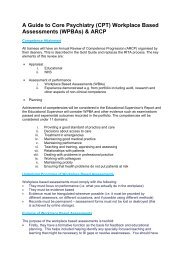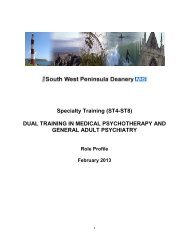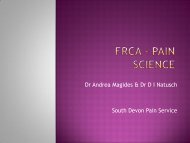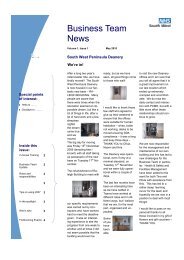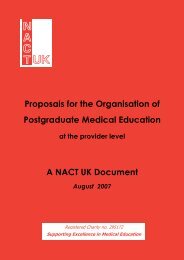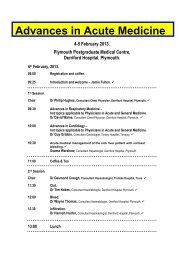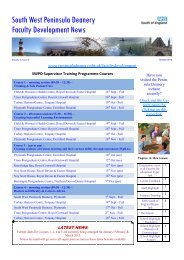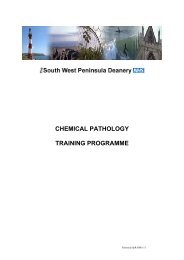General - South West Peninsula Deanery
General - South West Peninsula Deanery
General - South West Peninsula Deanery
You also want an ePaper? Increase the reach of your titles
YUMPU automatically turns print PDFs into web optimized ePapers that Google loves.
Operative Experience (Trainee)<br />
- Enter your electronic logbook totals for the total number of procedures that you have<br />
performed since you began surgical training (BST and HST) in the first three columns<br />
- Enter your electronic logbook totals for the number of procedures that you have performed<br />
during this training period in the three “Experience for this post” columns<br />
P<br />
PA<br />
A<br />
Performed without direct supervision (or supervising a junior trainee)<br />
Performed with supervision by a senior trainee or consultant (at table or in the<br />
theatre i.e. a consolidation of all logbook categories apart from P & A)<br />
Assisting a senior trainee or consultant<br />
- Note: Regardless of their level of competence, trainers are reminded that trainees can only<br />
operate under the direction of a named consultant<br />
Operative Competence Grading (Trainer)<br />
- Rate the trainee’s competence to perform each procedure at the end of this training period<br />
according to the following rating scale:<br />
U Unknown (not assessed) during this training period<br />
A Competent to perform the procedure unsupervised (deals with complications)<br />
B Does not usually require supervision but may need help occasionally<br />
C Able to perform the procedure under supervision<br />
D Unable to perform the entire procedure under supervision<br />
- Use the following checklist of core skills to help you when making your assessment (not all<br />
of these will apply to every procedure):<br />
Checks patient case record and that consent has been obtained<br />
Communicates well with the theatre team<br />
Thorough preparation (marking, catheter, antibiotics etc)<br />
Good scrub and aseptic technique<br />
Positions patient correctly on operating table<br />
Makes appropriate incision(s)<br />
Purposeful dissection in correct tissue planes<br />
Demonstrates sound knowledge of anatomy<br />
Familiar with all the steps of the procedure<br />
Uses the correct instruments efficiently<br />
Handles dangerous instruments safely<br />
Uses assistant(s) to the best advantage<br />
Possesses good hand-eye co-ordination<br />
Handles tissues gently and dextrously<br />
Reliable suturing and knotting techniques<br />
Sound repair or anastomosis<br />
Uses diathermy appropriately and safely<br />
Able to control bleeding by suction, clips or sutures<br />
Closes wound neatly and securely<br />
Timeliness: the procedure is unhurried but with no unnecessary delay<br />
Good documentation (operation note and postoperative instructions)



